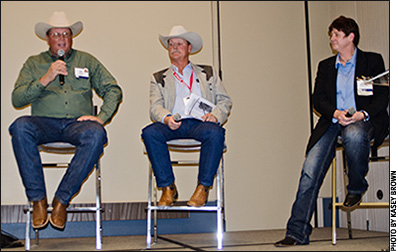
Ginette Gottswiller
The Source
Management practices shared to increase a commercial producer’s bottom line.
The National Angus Conference & Trade Show (NACTS) was an amazing educational opportunity for members earlier this month. There was something for everyone and that included commercial cattlemen, feeders, backgrounders and, of course, seedstock producers. If you want to increase your knowledge, mark your calendar to attend this event next November in Indianapolis, Ind.

Dave Rutan (left), Art Butler (center) and Ginette Gottswiller (right) shared ways to add value to commercial producers’ bottom line at the Angus Means Business National Convention & Trade Show.
The session I hosted, “Adding Value to your Customer’s Herd,” featured Art Butler of Spring Cove Ranch, and Dave Rutan of Morgan Ranches. We covered how Art has worked to help his commercial producers enhance the value of their calves. Dave Rutan did an amazing job through the years implementing management practices that have increased his bottom line. I’d like to share a few of those practices with you.
Today, Rutan has a fall-calving herd and leases his bulls to another progressive rancher, Craig Baker, of Sierra del Rio Ranch, for his spring-calving herd. Rutan, in turn, leases Baker’s bulls for his fall-calving herd. Baker and Rutan work together to buy the best bulls for their environment and goals. Rutan started this practice on his own operation in the early 1990s when he managed 500 spring- and 500 fall-calving cows. Both ranchers buy yearling bulls. Rutan manages irrigated pastures during the breeding season and manages a 35:1 ratio.
Choosing where to purchase your registered-Angus bulls is a difficult decision. Rutan has chosen to buy many of his bulls from Spring Cove Angus since the late 1980s. Butler and Rutan sat down and established goals for what would work best in their country. They have formed a working relationship that has been successful for both of them. One of Rutan’s early goals was to improve weaning weights. In 1989 Rutan’s average weaning weight for his herd was 412 pounds (lb.). Angus breed average in 1989 was 570.5 lb. overall or 599 lb. for the steers and 542 lb. for the heifers.
In 1989 breed average for weaning weight expected progeny difference (EPD) was +17. Rutan commented his average weaning weight was around +12. Bull purchase prices for Rutan averaged $2,500 per bull. He chose to add $1,000 to each bull purchase, and, on average, bought 10 bulls per year. Through the next seven years, his bull expense increased by $10,000 per year.
During those next seven years Rutan averaged an increase in weaning weight of 30 lb. per calf per year. I found historical price data from the Idaho/Oregon area from 1990 to 1996. I calculated the additional return per calf for each year. That total return over those seven years was $136,269 on the additional weaning weight from his fall and spring calf crop. The total increased bull expense was $70,000. The net gain over seven years was $66,269 or $9,467 per year on average. After 1996 the law of diminishing returns kicked in. Rutan says he will not purchase a bull that has an actual weaning weight lower than his calf crop’s average weaning weight.
Before AngusSource® became an American Angus Association program, Art Butler was emailing potential feedlot buyers telling them about specific lots of Spring Cove-sired calves that were available from his commercial producers. After AngusSource became a premiere marketing and age- and source-verification program for the Association, Butler provided financial incentives to some of his commercial producers to enroll in AngusSource. Dave Rutan was one of the producers Art Butler encouraged to enroll. Rutan was not sure of the advantages, but with Butler’s financial incentive he enrolled in 2003. When bovine spongiform encephalopathy (BSE) was reported in the United States, Rutan knew AngusSource had been the correct choice.
In 2008 our department began keeping AngusSource sale data from the video sales. Dave Rutan has been selling his calves on the Western Video sale in Reno, Nev. Our department uses CattleFax data for the week and region to figure the premium AngusSource-enrolled calves receive on sale day. Since 2008 Rutan has sold 2,726 calves at an average weight of 680 lb. The average premium on all the calves from 2008 to 2015 was $66.72 per head, which equates to total premiums earned of $181,901.95.
Rutan continues to look for ways to increase his bottom line, working with his seedstock provider and the American Angus Association to stay on the cutting edge of progress and profitability.
 Editor's Note: Ginette Gottswiller is the director of commercial programs for the American Angus Association.
Editor's Note: Ginette Gottswiller is the director of commercial programs for the American Angus Association.
[Click here to go to the top of the page.]





